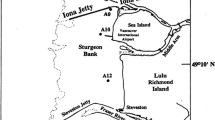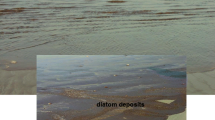Summary
Local abiotic and biotic data are presented from the Gröninger Plate (a sandy tidal flat south of Spiekeroog Island) covering a period of one year (February 1996 — February 1997), which includes the coldest part of the ice winter of 1995/96 as well as the winter of 1996/97. The thickness of the visible oxidized layer revealed a clear seasonality. Regarding sandy sediments, values were generally low and ranged between 2.9 cm in winter and 0.9 cm in summer. Biotic and abiotic data are restricted to composition and abundance of meiofauna taxa, total organic carbon, Chl a and phaeopigments as well as temperature and salinity. A significant reduction of meiofaunal abundance, particularly of nematodes, in the top 2 cm was recorded in samples taken in sediments covered by ice, as compared to sediments without an ice cover. However, vertical distribution of meiofauna under ice cover showed that nematodes had migrated to deeper sediment layers. The meiofauna appeared to have overcome the stress of low temperatures and ice formation better than the macrofauna.
Zusammenfassung
Örtliche abioische und biotische Daten von der Gröninger Plate, einer sandigen Wattfläche südlich von Spiekeroog werden über einen Zeitraum von einem Jahr (Februar 1996 – Februar 1997) dargestellt. Dieser Zeitraum schlieσt die kälteste Phase des Eiswinters 1995/1996 ein sowie den moderaten Winter 1996/1997. Die Dicke der sichtbaren oxidierten Schicht zeigt eine klare saisonale Schwankung. Angesichts des sandigen Sediments sind die Werte allgemein niedrig und schwankten zwischen 2,9 cm im Winter und 0,9 cm im Sommer. Die biotischen und abiotischen Daten sind beschränkt auf die Zusammensetzung und Abundanz von Meiofauna-Taxa, den gesamten organischen Kohlenstoff, Chl a- und Phaeopigment sowie Temperatur und Salinität. Eine eindeutige Reduktion der Meiofauna-Abundanz, speziell von Nematoden, wurde in Proben aus den oberen 2 cm sowohl des eisbedeckten wie des eisfreien Sediments registriert. Allerdings zeigte die vertikale Verteilung der Meiofauna unter der Eisdecke, daσ die Nematoden in die unteren Sedimentschichten gewandert waren. Die Meiofauna schien den Streσ der niedrigen Temperaturen und der Eisbildung besser überstanden zu haben als die Makrofauna.
Similar content being viewed by others
References
Asmus, R. C., C. Gätje andV. N. De Jonge, 1994: Microphytobenthos — empfindliche Oberflächenhaut des Wattbodens. In:J. L. Lozân, E. Rachor, K. Reise, H. von Westernhagen undW. Lenz. Warnsignale aus dem Wattenmeer. Berlin: Blackwell, 75–81.
Becker, G., 1996: Die hydrographischen Verhältnisse an der niedersächsischen Küste im Winter/Frühjahr 1996 (Strömungen, Temperatur, Eis). In: UBA (Umweltbundesamt), Fachkolloqium Schwarze Flecken im Wattenmeer 12.7.96, Berlin. UBA Texte 64/96, 28-32.
Bergmans, M., Dahms, H-U. andSchminke, H. K., 1991: An r-strategist in antarctic pack ice. Oecologia (Berl), 86, 305–309.
Beukema, J. J., 1979: Biomass and species richness of the macrobenthic animals living on a tidal flat in the Dutch Wadden Sea: effects of a severe winter.Neth. J. Sea Res.,13, 203–223.
Beukema, J.J., 1982: Annual variation in reproductive success and biomass of the major macrozoobenthic species living in a tidal flat area of the Wadden Sea.Neth. J. Sea Res.,16, 37–45.
Beukema, J. J., 1985: Zoobenthos survival during severe winters on high and low tidal flats in the Dutch Wadden Sea. In:J. S. Gray andM. E. Christiansen. Marine biology of polar regions and effects of stress on marine organisms. Wiley, Chichester, 351–361.
Beukema, J. J., Dörjes, J. andEssink, K., 1988: Latitudinal differences in survival during a severe winter in macrozoobenthic species sensitive to low temperatures.Senckenbergiana marit,20, 19–30.
Beukema, J. J., 1990: Expected effects of changes in winter temperatures on benthic animals living in soft sediments in coastal North Sea areas. In:J. J. Beukema, W. J. Wolff andJ. J. W. M. Brouns. Expected effects of climatic change on marine coastal ecosystems. Kluwer Academic Publ., Dordrecht, 83–92.
Buhr, K. J., 1981: Auswirkungen des kalten Winters 1978/79 auf das Makrobenthos derLanice-Siedlung im Weser-Ästuar. Veröff. Inst. Meeresforsch. Bremerh., 19, 115–131.
Cariou, Le Gall, V. andG. F. Blanchard, 1995: Monthly HPLC measurements of pigment concentrations from an intertidal muddy sediment of Marennes-Oléron Bay, France.Mar. Ecol. Prog.Ser.,121, 171–179.
Crisp, D. J., 1964: The effects of the winter 1962/63 on the British marine fauna.Helgoländer wiss. Meeresunters.,10, 313–327.
Dauer, D. M., 1984: High resilience to disturbance of an estuarine polychaete community.Bull. Mar. Sei.,34, 170–174.
Dörjes, J., 1978: Das Watt als Lebensraum. In:H.-E. Reineck. Das Watt. Ablagerungs- und Lebensraum. Verlag von Waldemar Kramer, Frankfurt am Main, 107–143.
Eisma, D., 1983: Geomorphology. In:W. J. Wolff. Ecology of the Wadden Sea. A. A. Balkema/Rotterdam.
Elbrächter, M., 1996: Phytoplanktonblüten in der Nordsee. In UBA (Umweltbundesamt), Fachkolloquium Schwarze Flecken im Wattenmeer 12.7.96, Berlin. UBA Texte 64/96, 63-67.
Farke, H., Rieman, F. andSchräge, M., 1985. High freezing tolerance of marine nematodes from intertidal sediments of the German Bight.Nematologica,30, 452–456.
Flemming, B. andA. Bartholomä, 1993: Ökosystemforschung Niedersächsisches Wattenmeer, B-Pilotphase, Schluσbericht des Teilprojektes B9. In Abschluσber. B-Pilotphase. Ökosys. Forsch, niedersächs. Wattenmeer, 1: Anh.
Flemming, B. W. andDavis, R. A., 1994: Holocene evolution, morphodynamics and sedimentology of the Spiekeroog barrier island system (southern North Sea).Senckenbergiana marit,24, 117–155.
Gerlach, S. andM. Schrage, 1971: Life cycles in marine meiobenthos. Experiments at various temperatures withMonhystera disjunta andTheristus pertenuis (Nematoda).Mar. Biol,9, 274–280.
Giere, O., 1993: Meiobenthology. The microscopic fauna in aquatic sediments. Berlin: Springer, 328 pp.
Gilbert, R., 1983: Sedimentary process of Canadian arctic fjords. In: J. P. M. Syvitzki and J. M. Skei. Sedimentology of fjords.Sed. Geol.,36, 147-175.
Grainger, E. H., 1991: Exploitation of arctic sea ice by epibenthic copepods.Mar. Ecol. Prog. Ser.,77, 119–124.
Höpner, T. andH. Michaelis, 1994: Sogenannte ’Schwarze Flecken’ - ein Eutrophierungssymptom des Wattenmeeres. In:J. L. Lozán, E. Rachor, K. Reise, H. von Westernhagen undW. Lenz. Warnsignale aus dem Wattenmeer. Berlin: Blackwell, 153–159.
Höpner, T. andB. Oelschläger, 1997: From the warning signal to the case of emergency. History, course and explanation of the black area event of summer 1996.Dt. hydrogr. Z., Suppl.7 (1997), 11–20.
Jansson, B.-O., 1968: Quantitative and experimental studies of the interstitial fauna in four Swedish sandy beaches.Ophelia,5, 1–71.
Kolbe, K., 1991: Zum Auftreten “schwarzer Flecken”, oberflächlich anstehender, reduzierter Sedimente, im ostfriesischen Wattenmeer. Ber. NLWA-Forschungsstelle Küste, Norderney, 26 pp.
Kogge, M., 1993: Biogeochemische und phänomenologische Untersuchungen zur Kenntnis der schwarzen Flecken. Diplomarbeit, Universtät Oldenburg, (unpublished).
Kraus, M. G. andB. W. Found, 1975: Preliminary observations on the salinity and temperature tolerance and salinity preference ofDerocheilocaris typica Pennak and Zinn 1943.Cah. Biol. Mar.,16, 751–762.
Lorenzen, S.,1968: Die Meiofauna an der Grenze Watt/Salzwiese im Bereich der deutschen Nordseeküste. Diss. Math. Nat. Fak. Kiel, 191 pp.
Meixner, R., 1979: Massenauftreten junger Miesmuscheln und Herzmuscheln im Sommer 1979.Infn. Fischw.,26, 180–181.
McIntyre, A. D., 1969: Ecology of marine meiobenthos.Biol. Rev.,44, 245–290.
Michaelis, H., 1987: Bestandsaufnahme des eulitoralen Makrobenthos im Jadebusen in Verbindung mit einer Luftbild-Analyse.Jahresbericht Forschungsstelle Küste Norderney,38, 13–97.
Michaelis, H., K. Kolbe andA. Thiessen, 1992: The “black spot disease” (anaerobic surface sediments) of the Wadden Sea. ICES C.M./E 36: 1-11. MURSYS (Meeresumwelt-Reportsystem) 1996. Bundesamt für Seeschiffahrt und Hydrographie, Hamburg. N2/96.
Neira, C. andM. Rackemann, 1996: Black spots produced by buried macroalgae in intertidal sandy sediments of the Wadden Sea: effects on the meiobenthos.J. Sea Res.,36, 153–170.
Niesel, V., 1997: Populationsdynamische und ökophysiologische Konsequenzen des Wattaufenthaltes für Phytoplankter der Nordsee. Diss. Universität Oldenburg, 142 pp.
Purschke, G., 1981: Tolerance to freezing and supercooling of interstitial Turbellaria and Polychaeta from a sandy tidal beach of the island of Sylt (North Sea).Mar. Biol.,63, 257–267.
Rachor, E., 1980: The inner German Bight — an ecologically sensitive area as indicated by the bottom fauna.Helgoländer wiss. Meeresunters.,33, 522–530.
Reichert, A. andJ. Dörjes, 1980: Die Bodenfauna des Crildumersieler Wattes (Jade, Nordsee) und ihre Veränderung nach dem Eiswinter 1978/79.Senckenbergiana marit,12, 213–245.
Rosen, P. S., 1979: Boulder barricades in central Labrador.J. Sed. Pet,49, 1113–1123.
Schaffner, L. C., R. J. Diaz, C. R. Olsen andI. L. Larsen, 1987: Faunal characteristics and sediment accumulation processes in the James River Estuary, Virginia. Est.Coast Shelf Sei.,25, 211–226.
Stal, L. J., H. Van Gemerden andW. E. Krumbein, 1984: The simultaneous assay of chlorophyll and bacteriochlorophyll in natural microbial communities.J. microbiol. Meth.,2, 295–306.
Strübing, K., 1996: The ice winter of 1995/96 on the German coasts between Ems and Oder, with a survey of the entire Baltic area.Dt Hydrogr. Z.,48, 73–87.
Sun, M., C. Lee andR. C. Aller, 1993: Anoxie and oxic degradation of 14C-labeled chloropigments and a 14C-labeled diatom in Long Island Sound sediments. Limnol.Oceanogr.,38, 1438–1451.
Tamaki, A., 1987: Comparison of resistivity to transport by wave action in several polychaete species on an intertidal sand flat.Mar. Ecol. Prog. Ser.,37, 181–189.
Taylor, R. B. andC. B. McCann, 1983: Coastal depositional land forms in northern Canada. In:D. E. Smith andA. G. Dawson. Shorelines in Isostasy. Academic Press, London, 53–75.
Vernberg, W. B. andB. C. Coull, 1975: Multiple factor effects of environmental parameters on the physiology, ecology, and distribution of some marine meiofauna.Cah. mar. Biol.,16, 721–732.
Westheide, W. andM. von Basse, 1978: Chilling and freezing resistance in two interstitial polychaetes from a sandy tidal beach.Oecologia,33, 45–54.
Wilde, P. A. W. J. de andE. M. Berghuis, 1979: Cyclic temperature fluctuations in a tidal mud-flat. In:E. Naylor andR.G. Hartnoll. Cyclic phenomena in marine plants and animals. Pergamon Press, Oxford, 435–441.
Ziegelmeier, E., 1964: Einwirkungen des kalten Winters 1962/63 auf das Makrobenthos im Ostteil der Deutschen Bucht.Helgoländer wiss. Meeresunters.,10, 276–282.
Ziegelmeier, E., 1970: Über Massenvorkommen verschiedener makrobenthaler Wirbelloser während der Wiederbesiedlungsphase nach Schädigungen durch “katastrophale” Umwelteinflüsse.Helgoländer wiss. Meeresunters.,21, 9–20.
Author information
Authors and Affiliations
Corresponding author
Rights and permissions
About this article
Cite this article
Neira, C., Höpner, T. & Rackemann, M. Annual course of sediment parameters and meiofauna on a sandy tidal flat in the wadden sea after the severe winter of 1995/96. Deutsche Hydrographische Zeitschrift 50, 301–311 (1998). https://doi.org/10.1007/BF02764227
Received:
Accepted:
Published:
Issue Date:
DOI: https://doi.org/10.1007/BF02764227




